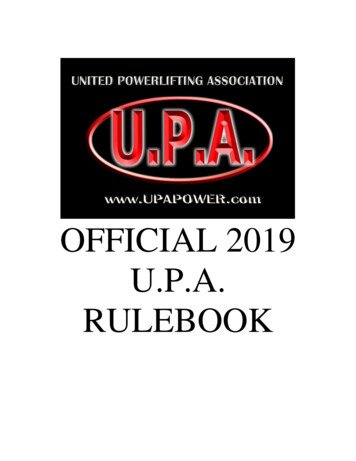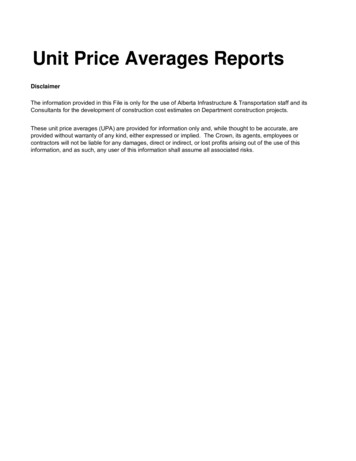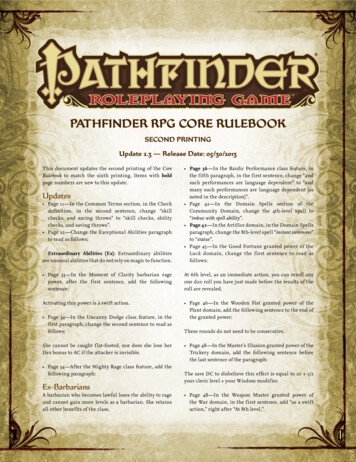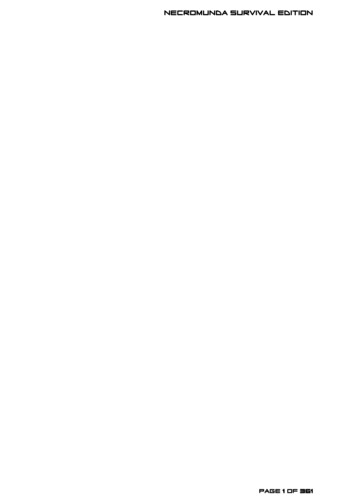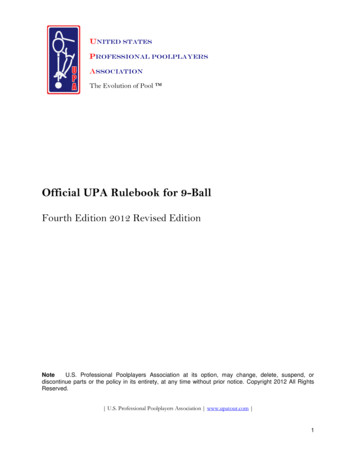
Transcription
United StatesProfessional PoolplayersAssociationThe Evolution of Pool Official UPA Rulebook for 9-BallFourth Edition 2012 Revised EditionNoteU.S. Professional Poolplayers Association at its option, may change, delete, suspend, ordiscontinue parts or the policy in its entirety, at any time without prior notice. Copyright 2012 All RightsReserved. U.S. Professional Poolplayers Association www.upatour.com 1
TABLE OF CONTENTSINTRODUCTION . 4. 51OBJECT OF THE GAME2LAG FOR BREAK . 52.1How to Rack . 52.2Rack your Own . 52.3Ball Tapping. 5. 53LEGAL BREAK SHOT49-BALL POCKETED ON BREAK . 65PUSH OUT . 66CONTINUING PLAY . 67BALL IN HAND FOUL PENALTIES . 687.1Cue Ball Fouls Only . 67.2Scratch . 77.3Bad Hit . 77.4No Rail . 77.5Balls off the Table . 77.6Foot on the Floor . 77.7Jump Shot . 77.8Moving Ball . 77.9Double Hit . 77.10Head String. 77.11Ball in Hand Placement . 77.12Interference . 77.13Making the Table . 87.14Use of Equipment . 8LOSS OF GAME . 88.1Opponent Wins . 82
910118.2Three Consecutive Fouls . 88.3Conceding a Game. 88.4Concession of Match . 88.5Coaching Assistance . 8GENERAL POOL RULES. 89.1Split Hits . 89.2Ball Rebounds from Pocket . 89.3Hanging Ball . 99.4Suspended Balls. 99.5Settling into Place . 99.6Jump Shots. 9TOURNAMENT DIRECTOR/REFEREES . 910.1Player Responsibility . 910.2Referees . 910.3Playing without a Referee . 910.4Questionable Shot . 1010.5Advice vs. Rules Clarification . 1010.6Prompting Warnings . 1010.7Calling Fouls . 1010.8Protesting Fouls. 1010.9Restoring Position . 1010.10Verification . 1010.11Replay of Game. 1010.12Resolving Disputes . 10SPECIAL RULINGS . 1111.1Addendum . 113
UPA OFFICIAL 9-BALL RULESINTRODUCTIONWelcome to the official 9-ball rules of the UPA. The rules you are about to read and understand arethe collaboration of years of deliberation from our Touring Professionals; both foreign anddomestic. Our professionals have come together to ensure a simple yet highly effective ruling systemthat is sure to challenge you as a player while evolving your level of play.Please note that due to issues of television, timed matches, and professional match play some rulesmay slightly differ from the actual professional tour. The following rules have been slightly amendedby our Touring Pros and are intended for amateur use in pool rooms across the nation. These rulesare utilized by the UPA Amateur League of Champions .It is our hope that your desire is to evolve your level of play and standard of sportsmanship. Goingforward, take the time to know and understand these rules so that you can also educate andencourage your fellow players. Furthering the education of our professional standards will result innationwide consistency that will overall help the vitality of the sport of pocket billiards in the UnitedStates of America.The United States Professional Poolplayers Association (UPA) is dedicated to the evolution of theentire sport of pocket billiards so that you can enjoy years of game play and continue to growpersonally from your experience in the game. The official motto of the UPA brand is TheEvolution of Pool as we are committed to every aspect of the sport and the vitality of it.Feel free to contact the UPA if you have any questions or comments so that we may be able tofurther assist you. Also be sure to join our League of Champions and watch your game rise toprofessional standards.Thank you and God bless,Frank Alvarez IIIFrank Alvarez IIIUPA President4
1. OBJECT OF THE GAMEThe object of 9-ball is to win by legally pocketing the 9-ball.The cue ball must strike the lowest numbered ball first for legal hit to occur. After the lowest ballis struck first, either the cue ball or any numbered ball may hit the 9 ball into any pocket for thewin. If the shooting player pockets the lowest numbered ball or other numbered ball after a legalhit, the shooting player continues his/her inning. If no ball is pocketed, either the cue ball or anynumbered ball must touch a rail after the cue ball contacts the lowest numbered ball for the shotto be legal.NOTE: If the 9-ball is pocketed illegally, then it is to be spotted on the foot spot with incomingplayer having “ball in hand.”2. LAG FOR BREAKThe Player with the lowest official UPA Speed (Rating) shall break first with an alternating breakformat taking place thereafter. In the event that two players with equal speeds play, a coin tossshall determine who breaks first with an alternating break format taking place thereafter. In nonleague play both players lag to the end rail and back to the head rail to determine who breaksfirst. Winner of lag is the player whose ball is closes to head of the rail.2.1 HOW TO RACK: The balls are racked in a diamond shape with the 1-ball on thefoot spot at the top of the diamond, the 9-Ball in the center of the diamond, the 2-ballat the bottom of the diamond, and the rest of the balls randomly dispersedthroughout the rack.2.2 RACK YOUR OWN: When there is no official available each breaking player shallbe responsible for providing himself/herself a legal and solid rack.2.3 BALL TAPPING: Tapping or touching balls is not permitted once the rack isremoved from the balls. The penalty for ball tapping/touching after the rack has beenremoved is a loss of break.3. LEGAL BREAK SHOTWith cue ball in hand behind the head string, the one ball must be struck first and any threenumbered balls must pass the center of the table. Balls dropping in any pocket counts as goingpast the center line.Break fouls include:a. If the cue ball is touched by the cue tip and does not meet the legal break requirement,it is a foul and gives the non-breaker an option of cue ball in hand or a re-rack and withthe original player breaking again.b. If the cue ball is pocketed or driven off the table, it is a foul and the non-breaking playerhas cue ball in hand.c. If any numbered ball leaves the table or comes to rest on top of a rail, it is a foul andthe non-breaking player has cue ball in hand.5
d. A foul on the break attempt counts towards the three fouls in the “three consecutivefouls” loss of game rule.4. 9-BALL POCKETED ON BREAK:Legally pocketing the 9-ball on the break wins the game for the breaker.5. PUSH OUTa. Only on the inning immediately following the break, the shooting player may elect tocall a “Push.” On a Push out, the shooter is required to hit the cue ball with the tip ofthe cue, but the cue ball is not required to touch another ball or a rail, therefore therules “BAD HIT,” “NO RAIL,” and “TABLE SCRATCH” under “BALL IN HANDFOULS” do not apply, but all other foul rules are still in effect. The shooting playermust declare his intention to push by saying “Push” or “Push Out” either to hisopponent or to the referee, or the shot is considered a normal shot. Any ballpocketed on a push stays down except the 9-Ball which would be spotted on the footspot immediately following the push. Following a legal push shot, the incoming playerhas the option to take the shot from the new layout or to pass the shot back to theplayer who pushed out. No matter who shoots next, on the shot immediatelyfollowing the push out, all “BALL IN HAND FOULS” now apply, and the normalcourse of play continues.6. CONTINUING PLAYOn the shot immediately following a legal break, the shooting player may play a “PUSH OUT.” Ifthe breaker pockets one or more balls on a legal break, he/she continues to shoot until hemisses fouls or wins the game. If the player misses or fouls, the other player begins an inningand shoots until missing, committing a foul, or winning. The game ends when the 9-Ball ispocketed on a legal shot or game is forfeited for serious infractions of the rules.7. BALL IN HAND FOUL PENALTIESWhen a player commits a ball in hand foul, he/she must relinquish his turn at the table. Theincoming player may now place the cue ball anywhere on the table to start his/her inning. If aplayer commits more than one foul on one shot, only one foul will be called. A player mustmake sure he/she has ball in hand before touching the cue ball. The following are cue ball inhand fouls:7.1 CUE BALL FOULS ONLY:a. Touching the cue ball: Touching or causing even the slightest movement of the cue ball(other than a normal shot), even accidentally, is a foul. However a player may use theferrule or shaft of his/her cue to line up his/her cue ball when a “cue ball in hand” is inplay (using the tip is a foul, and ball in hand will be given to the other player).b. Touching a moving object ball: Touching a moving object ball is a foul as is allowing amoving ball to hit a foreign object.6
c. Touching a still object ball: Any ball moved accidentally can only be replaced by theopponent. However the opponent may exercise the option of keeping disturbed ball(s)in new position if they so choose. The player who has committed the foul may movethe fouled object ball back to original position only after receiving consent from theopponent. If the player who has fouled touches any of the disturbed balls withoutconsent of opponent it will result in a loss of turn with ball in hand to the opponent.7.2 SCRATCH: Pocketing the cue ball or driving it off the table is a ball in hand foul.7.3 BAD HIT: If the first object ball contacted by the cue ball is not the lowestnumbered ball in the remaining order it is a ball in hand foul.7.4 NO RAIL: If, after the cue ball first strikes a legal ball, and neither the cue ball norany other ball hits a rail or is pocketed, it is a ball in hand foul.7.5 BALLS OFF THE TABLE: Except for a legal shot, causing any ball to come to restoff the playing surface is a foul. This includes any accidental movement of a ball whichresults in a ball falling into a pocket. The ball accidentally pocketed is not brought backinto play, and the incoming player has cue ball in hand.If a player knocks a ball off the table, it is a foul. If the ball returns to the playing surfaceafter hitting a person or an object, it is a foul. NOTE: If a player removes the 9-ballfrom the playing surface it results as a foul and the 9-ball is placed on the foot spot.7.6 FOOT ON THE FLOOR: Failure to have at least one foot on the floor at themoment the cue tip strikes the cue ball is a ball in hand foul.7.7 JUMP SHOT: Any miscue on a jump shot is a ball in hand foul. A legal jump shotmust be executed by stroking down through the cue ball (no scooping or miscues).7.8 MOVING BALL: Shooting while any ball is moving or spinning is a foul.7.9 DOUBLE HIT: If the cue tip strikes the cue ball twice on the same stroke it is a ballin hand foul. (Cue ball must be struck at a minimum of a 45 angle when in contact withintended object ball in order to avoid a double hit).7.10 HEAD STRING: The base of the cue ball must be inside the head string on thebreak or it is a ball in hand foul.7.11 BALL IN HAND PLACEMENT: To touch an object ball in any way while placingthe cue ball is also a foul.7.12 INTERFERENCE: Not remaining seated while the shooting player is at the tablemay result in a tournament official calling a foul for interference. The non-shootingplayer may check a table briefly in order to determine whether or not a referee shouldbe called, however must be seated again after determination. If a player shoots out ofturn, or moves any ball except during his inning, it is interference.Talking, making noises, moving around, causing distraction (sharking) in some way orconduct unbecoming that of a professional while the shooting player is at the table mayalso result in a tournament official calling a foul for interference.7
7.13 MARKING THE TABLE: Marking the table in any way, which could provide aplayer with an advantage in executing a shot, is a foul, unless the mark is removed tothe satisfaction of the opponent or referee prior to shooting.7.14 USE OF EQUIPEMENT: Out of play balls may not be used to measure gaps orspaces of any kind. Using any equipment in a non-customary manner is never allowedand constitutes a foul. It is the responsibility of the shooting player to know what theintended use of equipment; the bridge, jump cues, etc.8. LOSS OF GAME8.1OPPONENT WINS: The opponent legally pockets the 9-ball.8.2 THREE CONSECUTIVE FOULS: If a shooter commits a foul three times in arow without making an intervening legal shot, the result is a loss of game. The threeconsecutive fouls must occur in one game; fouls do not carry over to next game. Awarning must be given by the referee (or by the opponent, if referee is not present)before the possible third foul, for the third foul to be a loss of game.8.3 CONCEDING A GAME: Conceit of a game or games in tournament play isnever encouraged. The shooting player must finish his/her inning or no matter theresult, shall be a loss of game(s) for the conceding player.8.4 CONCESSION OF MATCH: Unscrewing any cues during the last game (orwhile the shooting player is on the hill), putting on a jacket, or undertaking any otheractions which would indicate that the match is over, is considered a forfeiture of thematch.8.5 COACHING ASSISTANCE: A player is only allotted the right to ask any teammember for input or advice in the planning or preparing to execute a shot once per gameand only during their inning. Should the player receive advice from respectiveteammates spontaneously or purposely the current game shall be forfeited in favor of theopponent.NOTE: When the shooting player decides to receive instruction from his/her team, theplayer is to call a “Time Out.” When a “Time Out” is called, the player is to then nameone of their team members. The team member selected is to immediately assist theplayer without conferring with other members and may not use any items or tools to aidthe shooting player.9. GENERAL POOL RULES9.1 SPLIT HITS: If the cue ball strikes a legal object ball and a non-legal object ballat about the same instant, and it cannot be clearly determined which ball was hit first,the judgment will go in favor of the shooter.9.2 BALL REBOUNDS FROM POCKET: Balls must remain in a pocket to count aspocketed. If a ball goes into a pocket and bounces back on to the playing surface, it isnot considered pocketed. If it is the 9-ball, it is not a win. If it is the cue ball, it is not a8
scratch. Clearing pockets which are full or nearly full of balls is the responsibility of theshooting player.9.3 HANGING BALL: If an object ball hangs in a pocket, the ball is considered to bepocketed if it drops in 5 seconds or less after coming to complete rest by the hole. If ahanging ball drops in the pocket after being at rest for 5 seconds or more, the ball isreturned to the original position on the edge and the incoming player’s may beginhis/her inning. Both players will have the opportunity to argue their case, and thereferee’s decision is final.9.4 SUSPENDED BALLS: If one or more balls become suspended in a pocketbeyond the edge of the slate because it is partially supported by other balls, it isconsidered pocketed if the removal of the supporting ball(s) would cause thesupported/suspended ball to fall into the pocket. Tournament officials are the solejudges of whether this rule applies to any situation.9.5 SETTLING INTO PLACE: A ball may settle slightly after it appears to havestopped, possibly due to slight imperfections in the cloth or table slate. Unless thiscauses a ball to fall into a pocket, it is considered a normal hazard of play, and will notbe moved back. If a ball falls into a pocket as a result of such settling, it is replaced asclose as possible to its original position on the lip of the pocket. If a ball falls into apocket during or just prior to a shot and it has an effect on the shot, the referee willrestore the ball to its original position and the shot will be replayed. Players are notpenalized for shooting while a ball is settling.9.6 JUMP SHOTS: It is legal to cause the cue ball to leave the surface of the tableby elevating the butt of the cue and, with a downward stroke, force the cue ball to riseoff the playing surface. For the shot to be legal only the cue tip may touch the cue ball– the shot must not be “scooped” by the ferrule or shaft. Any miscue on a jump shot isa ball in hand foul. A legal jump cue must be at least 40 inches in length andconstructed in typical cue fashion. NOTE: Standard jump cues are accepted includingphenolic tips. However cues that are not typical in appearance must be accepted andapproved by the United States Professional Poolplayers Association (UPA).10. TOURNAMENET DIRECTOR / REFEREES10.1 PLAYER RESPONSIBILITY: It is the responsibility of each member to be awareof all rules, regulations, and schedules relating to his/her competition. Tournamentofficials will make every reasonable effort to make the information readily available to allplayers; however, the ultimate responsibility rests with each individual player. There isno recourse if a player does not obtain correct or complete information. NOTE: Playersmay always call for rules clarification during league play. This is not considered a “TimeOut.”10.2 REFEREES: The League Operator (or his/her assistants) will perform the dutiesof a referee in the event that referees are busy or not utilized. If the TournamentDirector, his/her assistants or a referee is not to be found within a reasonable timeframe, a spectator may sub as an official referee when agreed upon by both players.10.3 PLAYING WITHOUT A REFEREE: When a referee or tournament official is notavailable, the players in the match will be responsible for racking balls, watching for9
fouls, and insuring adherence to the rules of competition. Both players may agree onan audience member to stand in and perform any duty of a tournament official.10.4 QUESTIONABLE SHOT: If there is a shot that could be a questionable hit orfoul, the seated player is responsible for calling for a tournament official to watch the hitbefore the opponent shoots. Once notified, the player at the table must then wait for anofficial to watch the shot. Likewise, if a player is uncertain whether some rule has beenbroken, he is responsible for seeking immediate clarification from league officials or rulebook before play continues. After play continues, it is unlikely that a problem can beremedied.10.5 ADVICE VS. RULES CLARIFICATION: The referee must NEVER give advicenor offer an opinion on points of play. Only when asked by either player for clarificationof a rule will the referee then explain that a specific rule to the best of his/her ability.Any incorrect statement by the referee will not protect a player from enforcement of theactual rule. When asked, the referee must tell either player the score, whether the cueball is frozen to an object ball or rail, etc. If the referee sees that a foul is about to becommitted by either player, he must say nothing until after the foul, since any warningbefore the foul would constitute “advice” from the referee.10.6 PROMPTING WARNINGS: When it is either player’s opinion that the referee isfailing to issue a mandatory warning, he/she may remind the referee that such awarning is necessary.10.7 CALLING FOULS: The referee will call all fouls as soon as they occur and willinform the incoming player that he/she has ball in hand.10.8 PROTESTING FOULS: If a player believes that the referee has failed to call afoul, he must protest to the referee before his/her opponent takes his/her next shot. Ifthe player fails to do so, the foul is considered not to have occurred.10.9 RESTORING POSITION: When it becomes necessary, the referee will restoredisturbed balls to their original positions to the best of their ability. The referee maysolicit information for this purpose, if he/she is not sure of original positions. If the ballswere disturbed by a player in the match, his/her opponent has the option of preventingrestoration. If the balls were disturbed by someone else, then it is a mandatory for thereferee to restore the balls. In this case, the referee may instruct the shooter to replaythe shot after restoration, if the outside interference had an effect on the outcome of theshot. If not, the referee will instruct the shooter to continue play after restoration.10.10 VERIFICATION: The referee may use any means to gather needed informationto make a decision concerning a disputed play or game situation.10.11 REPLAY OF GAME: If a tournament official or his/her appointed substitute,cannot make a clear determination of the facts or specific circumstances relating to agiven rule or game situation, the tournament official has the option of requiring that shotbe replayed or a game be restarted.10.12 RESOLVING DISPUTES: Any disagreement between the two players will beresolved by the League Operator or his/her appointed substitute, or any administrativemember of the UPA.10
11. SPECIAL RULINGSAny rule or situation not covered in this text shall be decided by the League Operator or his/herappointed substitute or any administrative member of the UPA in accordance with UPA idealsand guidelines in an expedient manner. Such expedient rulings shall then be considered by theadministration of the UPA and its Touring Professionals before further instruction orimplementation of the matter is finalized.a. ADDENDUM: From time to time there may be addendums issued by the UPA tothe UPA official Rule book and it is the individual player’s responsibility to keepcurrent.11
Official UPA Rulebook for 9-Ball Fourth Edition 2012 Revised Edition Note U.S. Professional Poolplayers Association at its option, may change, delete, suspend, or
